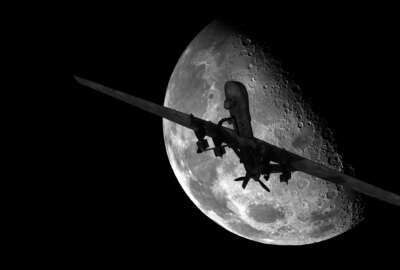
Air Force and NSF partner up to increase science workforce, bolster space tech
The two organizations signed a letter of intent to focus on four areas of science.
The Air Force and the National Science Foundation are teaming up for a military-civilian research partnership to increase the scientific workforce and work on space technology, one of the Air Force’s top priorities.
Air Force Secretary Heather Wilson and National Science Foundation Director France Cordova signed a May 9 letter of intent for the two organizations to collaborate on scientific and engineering research to bolster national security.
The collaboration focuses on space operations and geosciences; advanced material sciences; information and data sciences; and workforce and processes.
The partnership will bring together working groups from both the Air Force and NSF to share information, data and developments. Wilson and Cordova will also get together about twice a year.
The letter states the “Air Force will benefit from greater access to NSF’s considerably larger basic research program and community of researchers. The NSF will benefit with a direct pathway for the technical maturation of many of its research efforts and products, with increased relevance afforded by its direct support for the nation’s defense posture.”
Wilson added the NSF’s relationship with universities is one thing the Air Force hopes to tap into.
“The National Science Foundation is probably much better with universities than we are as the Air Force and they are much more focused on early stage research than we are, just by nature of our mission of what we do. As a result, we think by collaborating, we actually both benefit: that research that is done at the early stage can be transitioned to later stage research that is done at the Air Force,” Wilson said.
Cordova said the collaboration betters NSF’s ability to bring technologies from lab to market and the Air Force gives the NSF a new avenue to do that.
The Air Force is putting a strong emphasis on research and technology in its 2019 budget. The 2019 budget request gives the Air Force about $30 billion, a nearly $5 billion research and development bump from 2018 and a two-year increase of about $10 billion.
“Faced with an eroding technological advantage in an international environment of great power competition, the 2019 R&D budget invests heavily in innovative technologies, funds the modernization of our nuclear force and transforms major space capabilities to better perform in a contested environment,” Air Force Deputy Assistant Secretary for Budget Maj. Gen. John M. Pletcher said in February.
Space, which is one of the priorities of the partnership, is a top issue for the Air Force. The 2019 budget gives the service $8.5 billion for investments in new space systems.
In October 2017, Wilson outlined the growing need for her service to put more resources into space from building a common picture of what is happening in space to cultivating international norms and laws ruling the domain.
Wilson said first and foremost the Air Force needs to develop a common operating picture of what is going on in space.
The Air Force currently catalogues all of the satellites and debris floating around the earth and keeps an eye on them, but Wilson says that’s not enough.
“If you’re worried about malevolent action in space, you need more than a catalog. You need near real-time situational awareness of what’s really going on in space around you. Moving toward a more complex picture of what’s happening in space,” Wilson said.
Copyright © 2025 Federal News Network. All rights reserved. This website is not intended for users located within the European Economic Area.
Scott Maucione is a defense reporter for Federal News Network and reports on human capital, workforce and the Defense Department at-large.
Follow @smaucioneWFED





